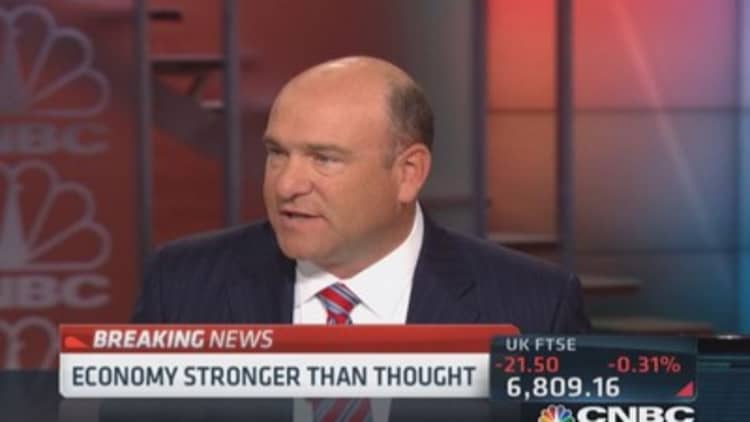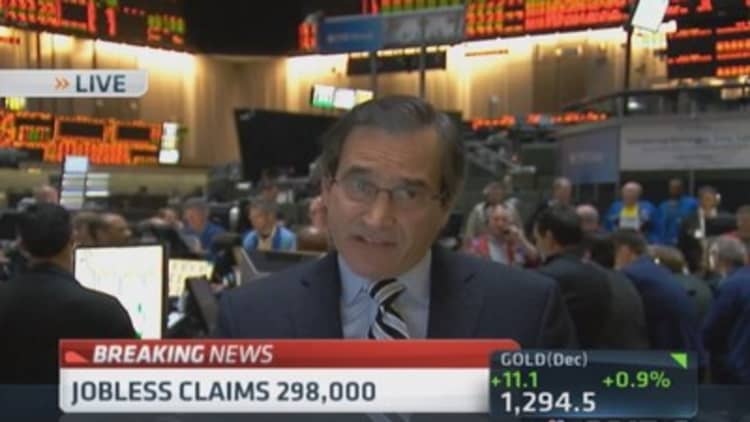
The U.S. economy rebounded more strongly than initially thought in the second quarter and details of a report on Thursday pointed to sustainable underlying strength.
A separate report showed the number of Americans filing new claims for unemployment benefits fell for a second straight week last week, underscoring strengthening labor market fundamentals.
Gross domestic product expanded at a 4.2 percent annual rate instead of the previously reported 4.0 percent pace, the Commerce Department said, reflecting upward revisions to business spending and exports.
It was the fastest pace since the third quarter of 2013.
The composition of growth in the second quarter was even more encouraging, with the sources of growth broad-based.
Domestic demand increased at a 3.1 percent rate, instead of the previously reported 2.8 percent pace. It was the fastest pace since the second quarter of 2010 and suggested the recovery was more durable after output slumped in the first quarter because of an unusually cold winter.
Economists polled by Reuters had expected the second-quarter GDP growth pace would be revised down to 3.9 percent. The economy contracted at a 2.1 percent pace in the first quarter.
Gross domestic income, which measures the income side of the growth ledger, surged at a 4.7 percent rate, consistent with strong job gains during the quarter. That was the largest increase since the first quarter of 2012.
This alternative growth measure decreased at a 0.8 percent pace in the first quarter.
Corporate profits rebounded from a decline that had been spurred by the expiration of a depreciation bonus.
Growth in consumer spending, which accounts for more than two-thirds of U.S. economic activity, was unrevised at a 2.5 percent rate.
Businesses accumulated $83.9 billion worth of inventory in the second quarter, less than the initially reported $93.4 billion. That saw restocking contributing 1.39 percentage points to GDP growth rather than 1.66 percentage points.
The relatively smaller inventory build means less stock overhang, which bodes well for third-quarter GDP growth.
While trade was a drag for a second consecutive quarter, export growth was raised to a 10.1 percent pace from a 9.5 percent rate. Business spending on equipment and nonresidential structures, such as gas drilling, was revised higher.
Housing market-related spending was revised slightly down as was government spending.
Jobless line shortens

Elsewhere, Initial claims for state unemployment benefits slipped 1,000 to a seasonally adjusted 298,000 for the week ended Aug. 23, the Labor Department said, although claims for the prior week were revised to show 1,000 more applications received than previously reported.
Economists polled by Reuters had forecast claims climbing to 300,000 last week. A Labor Department analyst said there were no special factors influencing the state level data.
The four-week average of claims, considered a better measure of labor market trends as it irons out week-to-week volatility, fell 1,250 to 299,750, pointing to sturdy job gains and an economy that is growing above its potential.
Job growth has topped 200,000 for six consecutive months, a stretch last seen in 1997, while the economy expanded at a 4.2 percent annual pace in the second quarter.
The jobless claims report showed the number of people still receiving benefits after an initial week of aid increased 25,000 to 2.53 million in the week ended Aug. 16.
The so-called continuing claims covered the period the government samples households to calculate the unemployment rate for August. Continuing claims increased 19,000 between the July and August household survey weeks, suggesting little change in the jobless rate, which was at 6.2 percent last month.
The unemployment rate for people receiving jobless benefits was 1.9 percent for the seventh consecutive week.
--By Reuters

